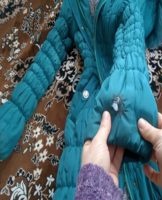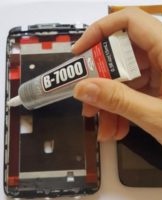How to glue furniture edge tape with your own hands at home
Cheap types of furniture are made from pressed wood (chipboard, laminated chipboard). These products are aesthetic and durable. When assembling furniture, a necessary stage of work is edge trimming - sealing of side cuts in order to hide the inside of the plates, protect them from moisture and give products beauty and completeness. Let's see how to glue furniture edging tape correctly so that things last a long time and please their appearance.
What is the advantage for furniture
Edging materials hide the inside of the chipboard and extend the life of the furniture. Another task of the edges is to reduce the evaporation of the resins with which the panel material is impregnated. There are several requirements for edging materials:
- decent appearance - aesthetics;
- strength and durability;
- reliable fixation on the edge of the furniture;
- ease of fixing.
The materials offered by the industry fully meet these requirements. It only remains to choose.
Paper and melamine
A border made of paper impregnated with a special resin (melamine) is the most economical option for finishing the edges. Heavy papers receive additional strength and resistance to external influences thanks to melamine. It is easy to work with such material - it does not break, it bends at any angle.
The most common material thicknesses are 0.2 and 0.4 millimeters. For ease of use, an adhesive is applied to the melamine edge, which activates when heated.
The melamine paper is not afraid of water and does not fade under the influence of the sun, it is resistant to scratches and household chemicals. The main disadvantage is that it rubs off, not durable. It is advisable to place such edges on those areas of furniture that are not exposed to constant stress - on the back of shelves, table tops.
PVC
Polyvinyl chloride is a durable material that has found applications in various fields of activity, including medicine. PVC edge banding is suitable for finishing the front areas of furniture. The manufacturer produces material in different colors, it is easy to choose the edge to match the product color or contrast.
Benefits :
- strength, long life with high quality sticker;
- flexibility - the ability to attach to furniture with any curvature of the edge;
- resistance to any type of impact - chemicals, sun, friction.
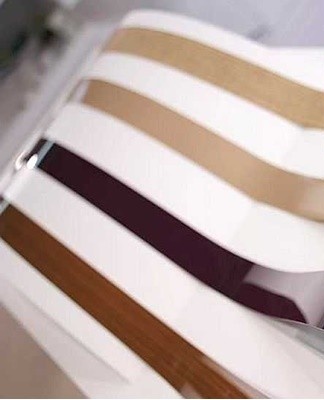
A wide selection of materials in thickness (from 0.4 to 4 millimeters) and width allows you to create various types of designer furniture. PVC curbs are available with an adhesive or single component.The disadvantage of PVC edge is its sensitivity to temperatures - furniture should not be left cold, while gluing should not be very hot.
ABS plastic
ABS plastic is a type of expensive edging material. It is usually used on more expensive furniture models. The advantages of thermoplastic edges include:
- high-quality material, no harmful components in the composition;
- impact and wear resistance;
- during long-term use, it does not lose its color and appearance.
The border is available in matte and glossy versions. Lack of material - high price. ABS plastic is used when high strength is required, operation in aggressive environments - temperature, chemical attack.
veneer
Veneered edges are made from a thin layer of wood, in most cases in the manufacture of furniture. It is difficult to work with the material at home - experience and knowledge are necessary. The material is expensive, it is used to trim veneer furniture.
Acrylic or 3D
A two-layer edge is made of acrylic - the lower part has a three-dimensional pattern that performs a decorative function, the upper part is removed after gluing and serves as a protection.
The 3D effect on the edge adds beauty and continues the pattern of the main cabinet. The garment looks sturdier, the hem works to create the overall look and doesn't look like a simple edging. The disadvantage is the high price, there are many advantages - from aesthetics to high strength.

Varieties of profiles
The edges of the furniture are processed not only with the edge. One of the decorative and protective means of finishing the cuts are profiles - special coatings that are placed on the saw cut or inserted into pre-cut grooves in the chipboard.Profiles change the appearance of furniture, serve as an additional decorative element, effectively protect the interior of chipboard from the external environment.
T-shaped
To process the edges with a T-shaped profile, a groove is cut in advance with a milling cutter with a knife. At the final stage of furniture assembly, the profile is inserted into the prepared hole (hammered with a soft hammer). T-shaped profiles are made with a strap or with simple overlays on the edge. Usually aluminum or PVC is used.
U-shaped
C- or U-profiles do not require a slot in the grooved plate, they are simply laid on the edge and reinforced with glue. It is important to choose a good adhesive and to attach the stamp well to avoid voids. U-shaped pads are made from soft and hard materials. Rigid parts are stronger, but assembly on rounded edges is more difficult. The profile will need to be warmed up to give flexibility and fasten with tape until the glue dries.
Important: the sides on the profile hide a poor-quality edge cut, small chips on the surface of the facades. The profile not only acts as a protector of chipboard, but also decorates furniture.
How to stay with your own hands
For work you will need - a sharp knife, gloves, glue or a heating device, depending on the selected edge parts. You also need to get a rag or roller to press the pieces together.
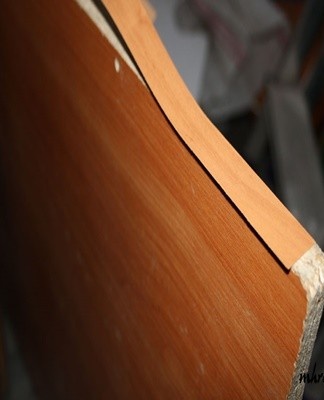
Use an iron or hair dryer
A hot melt adhesive is applied to the melamine and PVC edges, which becomes tacky when heated.To work with such products, you need an iron or a hair dryer. The surface to which the edge is glued is placed horizontally. Cut a piece of fabric 2 to 3 centimeters longer than the cut length. Mode 2 ("Silk") is placed on the iron and a protective pad is put on (cover the soleplate with a cloth if it is not there).
Run the iron along the edge, melting the glue. It is better to start work from the middle and move one by one to the edges of the room. It is impossible to strongly press the sole, so as not to move the edge and squeeze out the glue. After the glue has melted, the iron is removed along the entire edge, the part is pressed with a rag, ensuring a tight connection.
The edges are cut with a sharp knife near the end. If the edge is wider than the piece, it must be cut lengthwise. Use a knife and a metal ruler. For PVC, it is preferable to use a hand milling machine, melamine is easily cut with a knife. Cut edges are smoothed with sandpaper to remove burrs.
Stick ribbons without glue
Experts consider non-adhesive edges to be more comfortable and reliable. It is necessary to purchase the recommended glue for this material and follow the instructions exactly.
The technology is simple:
- apply glue without excess on the cut and the edge;
- wait the recommended time (if required in the instructions);
- carefully combine details;
- using a roller or a folded cloth, firmly press the edge against the edge of the furniture;
- leaking glue is quickly removed so you don't have to use solvent.
You need to press the parts firmly, iron them with a cloth until they are glued, in order to avoid the formation of bubbles.When finished, remove the glue particles, cut off the ends, grind the edge with sandpaper.
How to glue chipboard and chipboard at home
The structure of the chipboard is loose, it is sawdust and shavings mixed with glue and pressed. Due to this looseness, the material is resistant to warping and splitting, as well as flexible.
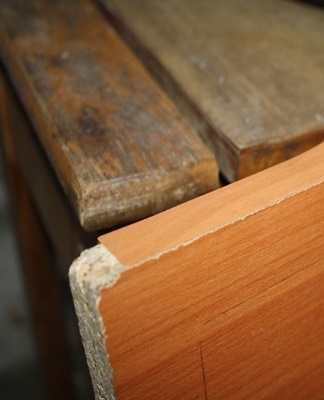
The unsightly interior is visible on the saw cut of the chipboard, the material is uneven, often crumbles. Experts recommend to putty the cut before sticking the tape in order to level the surface, to ensure a solid connection with the edge. Use multi-purpose acrylic fillers.
The cut is putty, wait for drying (carefully remove excess funds from the facades). Then they are treated with medium-grit sandpaper. If there is no glue on the edge, choose the one recommended by the manufacturer. It's also worth stocking up on glue remover to remove any dried-on stains if needed.
Common Mistakes
The most common mistakes made by inexperienced craftsmen are:
- Bubble formation. Occurs due to weak heating of the adhesive base or improper pressure of the edge on the workpiece. You will need to warm up with an iron and press more carefully.
- Edge offset. It is important to quickly eliminate this shortcoming, returning the part to its place. Otherwise, you will have to tear and stick a new part.
- There are pieces of dried glue on the furniture. Adhesive should be hot stripped until dry and solid. This is done with gloves so as not to hurt your hands.
Frozen glue is removed with sandpaper or solvent.It is important to find the right product.
Tip: Edging is necessary even for invisible areas of furniture - it will protect the chipboard from moisture absorption and deformation of the material.
Additional tips and tricks
Professional advice will make the job easier:
- Trimming excess melamine edgebanding may leave a slight edge along the piece. You can paint it and stain it with the base with wood stain.
- To work with any edging material, use short, very sharp knives (knives).
- Before starting work, the sole of the iron is cleaned of carbon deposits and dirt. The temperature is adjusted empirically by checking the melting of the adhesive layer on a small piece of tape (not on furniture).
- Wear gloves when working with heated appliances (iron, hair dryer) - hot glue can burn you.
- When cutting PVC edges (2 mm or more), it is best to use a router.
- Siding with an edge (you can choose the cheapest melamine material) should be made of all open cuts of the boards.
Grinding the glued part improves the appearance, eliminates small burrs. You can use a block to which the sandpaper is attached.
Automatic edging saves money when ordering furniture. The work does not belong to the category of difficult craftsmen, even inexperienced craftsmen can do it. The edge of all cutouts is glued immediately after assembling the furniture, without waiting for the edges of the chipboard to begin to wrinkle and crumble. Inexpensive materials will protect against moisture and fungus, extend the life of things.


